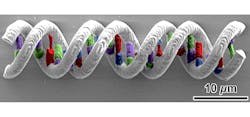Engineers at the University of Maryland (UMD; College Park, MD) have created a new multimaterial 3D laser-based nanoprinting technique that uses a simple molding process that is widely used in most microfluidics labs. The technique can print complex nanostructures from up to five different materials that include transparent optical materials.1
To demonstrate their new approach, the researchers 3D nanoprinted a variety of multimaterial components, including a five-material DNA structure, a multimaterial “microcello,” and a four-material microscopic UMD logo.
In one application of this new approach, UMD’s Bioinspired Advanced Manufacturing (BAM) Laboratory is working with the Food and Drug Administration to apply this strategy to 3D nanoprint parts of the human eye that include complex anatomy with varying optical properties.
The UMD researchers have filed two U.S. provisional patents for their strategy, which is based on a process called “in-situ direct laser writing” and work published earlier this year. The multimaterial structures are 3D-nanoprinted directly inside of microchannels, with distinct liquid materials loaded into the channel one at a time for material-specific printing. Once the printing process is finished, the microchannel enclosure can be removed, leaving behind fully integrated multimaterial 3D structures in a fraction of the time, yet with better precision than the state of the art.
“This new ability to 3D nanoprint systems comprising materials with target chemical, biological, electrical, optical, and/or mechanical properties,” says Ryan Sochol, an assistant professor in mechanical engineering and bioengineering at UMD’s A. James Clark School of Engineering, “offers a promising pathway to breakthroughs in areas including drug delivery, advanced optics, meta-materials, and microrobotics.”
Source: https://eng.umd.edu/news/story/new-multimaterial-3d-nanoprinting-strategy-could-revolutionize-optics-photonics-and-biomedicine
REFERENCE:
1. Andrew C. Lamont et al., Lab on a Chip, Vol. 19, Issue 14, pp. 2340-2345 (2019); http://dx.doi.org/10.1039/C9LC00398C.

